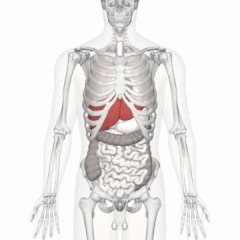Fetal liver
| Liver | |
|---|---|

Human liver shown in abdomen
|
|

Location of human liver (in red) in animation
|
|
| Details | |
| Precursor | Foregut |
| System | Digestive system |
| Artery | Hepatic artery |
| Vein | Hepatic vein and hepatic portal vein |
| Nerve | Celiac ganglia and vagus nerve |
| Identifiers | |
| Latin | Jecur, iecur |
| Greek | Hepar (ἧπαρ) root hepat- (ἡπατ-) |
| MeSH | A03.62 |
| TA | A05.8.01.001 |
| FMA | 7197 |
|
Anatomical terminology
[]
|
|
The liver is a vital organ of vertebrates and some other animals. In humans, it is located in the upper right quadrant of the abdomen, below the diaphragm. The liver has a wide range of functions, including detoxification of various metabolites, protein synthesis, and the production of biochemicals necessary for digestion. It also plays a role in metabolism, regulation of glycogen storage, decomposition of red blood cells and hormone production.
The liver is a gland. It is an accessory digestive gland and produces bile, an alkaline compound which aids in digestion via the emulsification of lipids. The gallbladder, a small pouch that sits just under the liver, stores bile produced by the liver. The liver's highly specialized tissue consisting of mostly regulates a wide variety of high-volume biochemical reactions, including the synthesis and breakdown of small and complex molecules, many of which are necessary for normal vital functions. Estimates regarding the organ's total number of functions vary, but textbooks generally cite it being around 500.
...
Wikipedia
